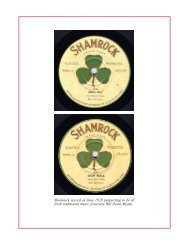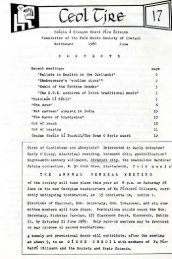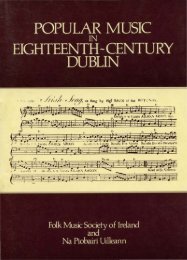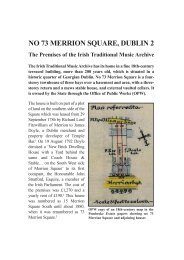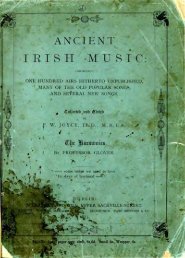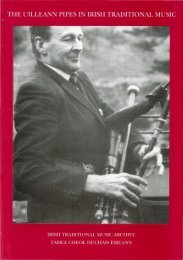Union Pipes - Irish Traditional Music Archive
Union Pipes - Irish Traditional Music Archive
Union Pipes - Irish Traditional Music Archive
You also want an ePaper? Increase the reach of your titles
YUMPU automatically turns print PDFs into web optimized ePapers that Google loves.
COURTNEY’S ‘UNION PIPES’ AND THE TERMINOLOGY OF IRISH BELLOWS-BLOWN BAGPIPES 2<br />
history of the term. Other terms for the uilleann pipes are also traced.<br />
As well as core questions of terminology, consideration of ‘union<br />
pipes’ also necessarily touches on the whole history and<br />
historiography of <strong>Irish</strong> bagpiping, and involves other dimensions of<br />
<strong>Irish</strong> musical culture: artistic processes and allegiances; national<br />
identity and self-representation, especially in relation to the <strong>Irish</strong><br />
language; and the ongoing globalisation of <strong>Irish</strong> traditional music.<br />
It must be emphasised that only the history of the term is being<br />
centrally addressed, not the history of the instrument itself. Although<br />
the two are of course related, they have led somewhat independent<br />
lives. Changes in terminology did not necessarily reflect<br />
developments in the physical nature of the instrument; such<br />
developments did not necessarily lead to the introduction of new<br />
terminology.<br />
But to provide a context for the discussion of piping terminology,<br />
some brief consideration of the history of the instrument itself is<br />
unavoidable. Bagpipes are musical wind instruments consisting of a<br />
reeded melody-pipe or chanter with finger-holes by which the player<br />
produces melody, an attached skin bag acting as an air-reservoir, a<br />
blow-pipe attached to the bag by which the player inflates it, and,<br />
normally, reeded fixed-pitch melody-pipes attached to the bag which<br />
provide a droning accompaniment to the chanter. Known in classical<br />
times, they are immemorially old and of uncertain origins. By the<br />
Middle Ages they were a common instrument, existing in many<br />
different forms across Europe, and in Asia and north Africa. Played<br />
mainly out of doors, and usually by professional players of low<br />
status, they are thought to have reached the limits of their popularity<br />
in western Europe from the fourteenth century to the seventeenth. 4<br />
4<br />
Baines 1995: 100.



